
The Thomisidae are a family of spiders, including about 170 genera and over 2,100 species. The common name crab spider is often linked to species in this family, but is also applied loosely to many other families of spiders. Many members of this family are also known as flower spiders or flower crab spiders.

Deinopidae, also known as net casting spiders, is a family of cribellate spiders first described by Carl Ludwig Koch in 1850. It consists of stick-like elongated spiders that catch prey by stretching a web across their front legs before propelling themselves forward. These unusual webs will stretch two or three times their relaxed size, entangling any prey that touch them. The posterior median eyes have excellent night vision, allowing them to cast nets accurately in low-light conditions. These eyes are larger than the others, and sometimes makes these spiders appear to only have two eyes. Ogre-faced spiders (Deinopis) are the best known genus in this family. The name refers to the perceived physical similarity to the mythological creature of the same name. This family also includes the humped-back spiders (Menneus).
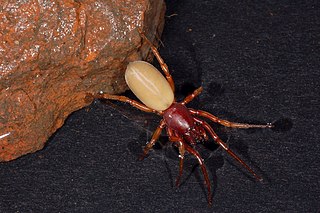
Dysderidae, also known as woodlouse hunters, sowbug-eating spiders, and cell spiders, is a family of araneomorph spiders first described by Carl Ludwig Koch in 1837. They are found primarily in Eurasia, extending into North Africa with very few species occurring in South America. Dysdera crocata is introduced into many regions of the world.
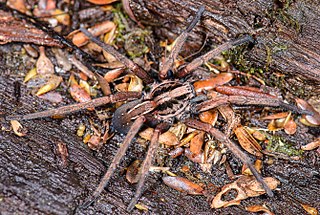
Miturgidae is a family of araneomorph spiders that includes nearly 170 species in 29 genera worldwide. First described by Eugène Simon in 1886, it has been substantially revised, and includes the previous family Zoridae as a synonym, and excludes the family Xenoctenidae. Several genera have also been removed, such as the large genus Cheiracanthium, which was transferred to the Cheiracanthiidae.

Ludwig Carl Christian Koch was a German entomologist and arachnologist.
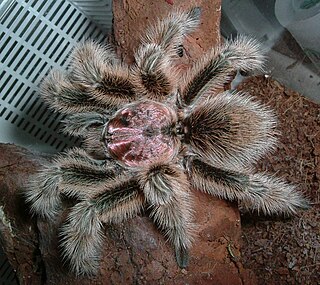
Grammostola is a genus of South American tarantulas that was first described in text by Eugène Louis Simon in 1892. These medium- to large-sized spiders are native to tropical South America, and are usually brown in color, with pinkish or orangish-red hairs. The very docile Chilean rose tarantula is popular as a beginner's spider among tarantula enthusiasts.
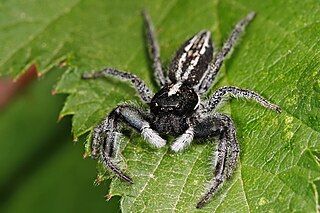
Ocrisiona is a genus of jumping spiders that was first described by Eugène Louis Simon in 1901. O. frenata from Hong Kong belongs to a different, unspecified genus, according to Marek Żabka (1990). Eugene Simon places the genus Ocrisiona close to Holoplatys.

Paraphidippus is a genus of jumping spiders that was first described by Frederick Octavius Pickard-Cambridge in 1901. The name is a combination of the Ancient Greek "para" (παρά), meaning "alongside", and the salticid genus Phidippus.

Thiania is a genus of jumping spiders that was first described by Carl Ludwig Koch in 1846.
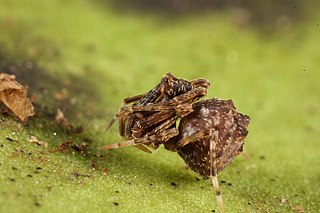
Archaeidae, also known as assassin spiders and pelican spiders, is a spider family with about ninety described species in five genera. It contains small spiders, ranging from 2 to 8 millimetres long, that prey exclusively on other spiders. They are unusual in that they have "necks", ranging from long and slender to short and thick. The name "pelican spider" refers to these elongated jaws and necks used to catch their prey. Living species of Archaeidae occur in South Africa, Madagascar and Australia, with the sister family Mecysmaucheniidae occurring in southern South America and New Zealand.

Cycloctenidae is a family of spiders first described by Eugène Simon in 1898.

Diplura is a genus of South American curtain web spiders that was first described by C. L. Koch in 1850. It is found in South America and Cuba belonging to the subfamily Diplurinae.
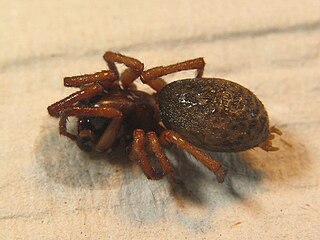
Inermocoelotes is a genus of funnel weavers first described by S. V. Ovtchinnikov in 1999.

Gnaphosa is a genus of ground spiders that was first described by Pierre André Latreille in 1804. They all have a serrated keel on the retromargin of each chelicera.

Agyneta is a genus of dwarf spiders that was first described by J. E. Hull in 1911.

Eratigena is a genus of spider in the family Agelenidae. Most of its species were moved from the genus Tegenaria in 2013, of which the genus name is an anagram. Two species that frequently build webs in and around human dwellings are now placed in this genus: the hobo spider, native to Europe and Central Asia and introduced to North America, and the giant house spider, native to Europe and also introduced into North America.

Desis is a genus of intertidal spiders that was first described by Charles Athanase Walckenaer in 1837. Species of the genus are found in Australasia, the Pacific, Japan, eastern and southern Africa, and India. They are marine spiders, living in the intertidal zone and only emerging at the ebb tide to hunt for invertebrates including shrimp. When submerged during high tides, they stay in an air chamber sealed with silk, and breathe its air.

Corinna is a genus of corinnid sac spiders first described by Carl Ludwig Koch in 1841. They are found in Mexico and south to Brazil, and with selected species found in Africa.
Asthenargus is a genus of dwarf spiders that was first described by Eugène Louis Simon & L. Fage in 1922.
Echemus is a genus of ground spiders that was first described by Eugène Simon in 1878.



















